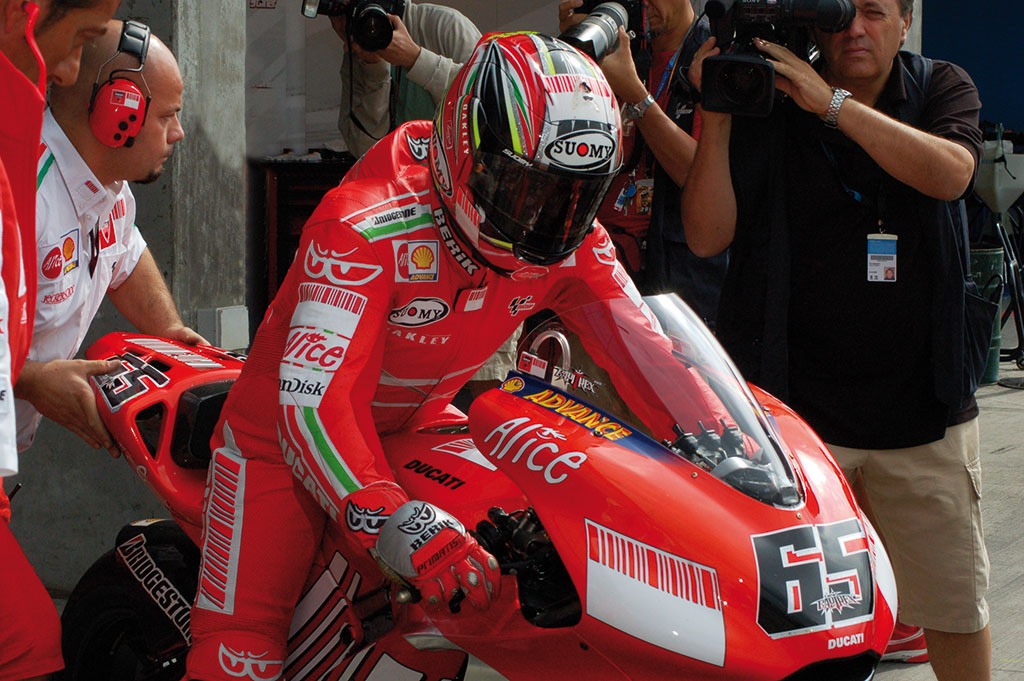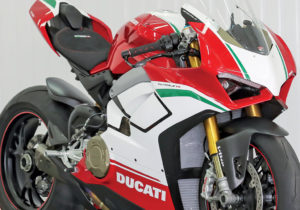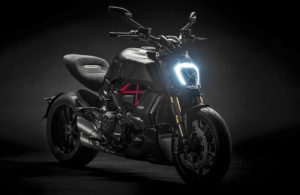When a rider decides to retire, talking about it without falling into the coils of rhetoric becomes difficult: the tendency to emphasize the competitive curriculum that has marked a life spent with dumbbells in hand becomes a well-concealed trap, where invariably those who are called to write slip.
Every rider who stops, detaches a credit that arises from the affection of being the son of a certain competitive period, a credit destined to revalue as this period climbs back in time and takes its place in the history of racing.
The riders do something that in our eyes of ordinary people has a mythical component that makes us admire them, live a life on the edge of the thousandths and ride motorcycles that are for a few.
In this context, a name, that of Loris Capirossi,is certainly worth more than one sentence. Parlando di lui non esiste il pericolo di cadere nella trappola della retorica: potremmo a tutti i costi (e per assurdo) voler essere freddi e distaccati, sciorinando la lunga sequenza di risultati, ma Loris, anche dalla fredda risultanza di schemi e numeri, ne uscirebbe
Loris Capirossi: the results of a great rider
With Capirossi, on the other hand, we want to free ourselves from the numbers and try to explain their value almost regardless of the pure and simple results. Let’s start from the fact that he was able to present himself on the world stage by immediately winning the title of class 125, in 1990: the youngest ever to have succeeded.
After winning the title in this class also in the following year, here is the quarter of a liter: Loris immediately proved to be a leathery rider,also growing up as a man, because for no one as for Capirossi competitive life coincides with personal life.
Already in the second season in 250 he was one of the best ever: only four points separated him from the world title won by Harada: a title that seemed already won and that faded in the last race in Jarama.
Loris, however, is a serious one, who joined the arrembante patrol of Italian riders of the 250 (Reggiani, Romboni and Biaggi) and who will be third the following year, before moving on to the queen class with the Honda NSR.
1995 is a difficult year, characterized by Doohan’sundisputed domination: after his initial apprenticeship, Loris is often one step away from the podium, on which he manages to climb to Barcelona.
In 1996 he moved to The Yamaha of Wayne Rainey’s team: another difficult season, which will see him retire often, but which will give him the first victory in the 500 class at Eastern Creek: once again a good performance in the last race of the season. la prima vittoria nella classe
In
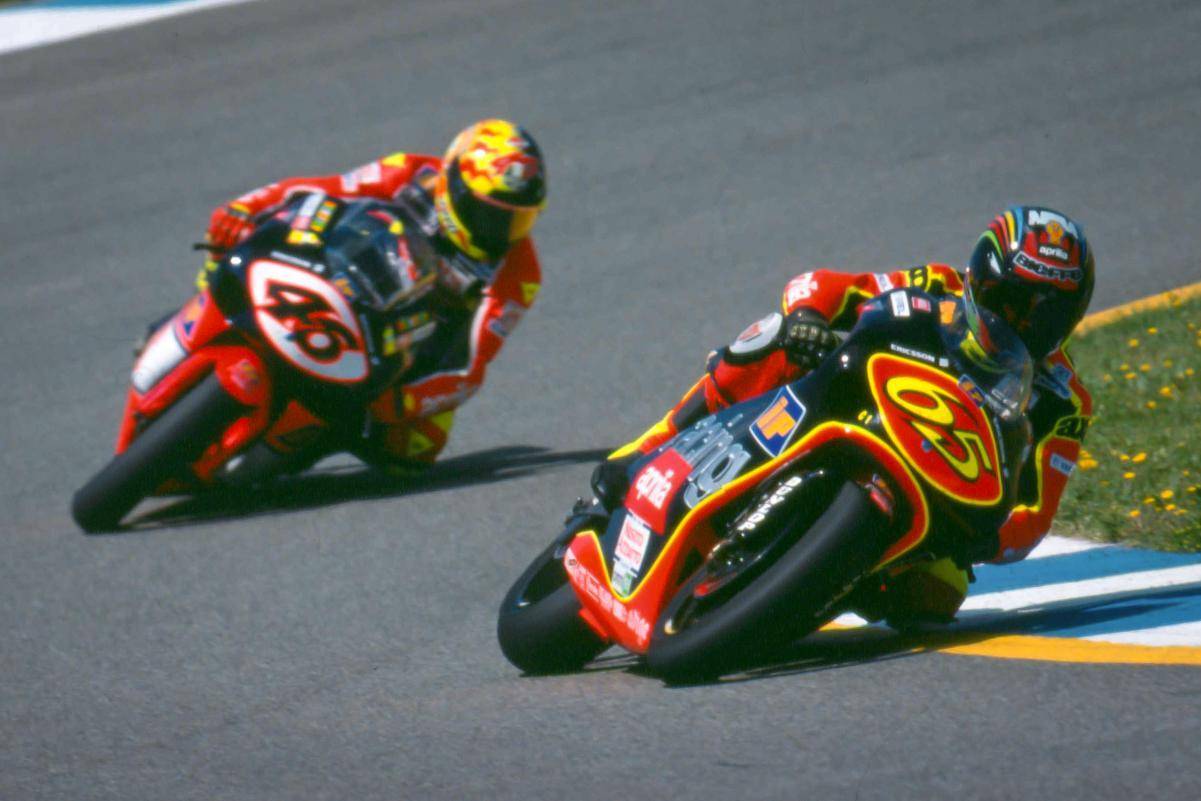
In 1999 Capirossi moved to Honda and eventually finished third, behind Rossi and Ukawa.
The year 2000 is the year of the return in 500: the Italian patrol that, until the year before, has reigned in the “two and a half” is now gathered in the queen class. With
2001 is the last year before the 4-hour revolution and the scene is almost entirely of our drivers: Rossi wins the first of his titles in the top displacement, struggling with Biaggi and Loris, who will end up in this order behind him. For the others, all that remains is crumbs: the Italians monopolize the podium on more than one occasion.
The following year the 4-speed bikes debuted. Loris has the old 2-time NSR of the Sito Pons team and with that he defends himself, often arriving on the podium, although it is now clear that the 500 can not stand the comparison with MotoGP.
However, 2002 is very important for Loris Capirossi, who cares about it: during the Mugello weekend, Ducati presents the Desmosedici. With it, in Borgo Panigale it was decided to make the big leap, debuting among the prototypes. In the presentation room, Loris is the only rider in business present. At the time it had not yet been made official, but he will be one of the riders who will take her to the race the following year; the other is Troy Bayliss.
Loris Capirossi’s first time on the Ducati Desmosedici
This is how the Ducati motogp adventure was born:the bike is fine and scary for the opponents. Loris started in the best way, with the first half in the pre-season tests in Barcelona and becoming the flag of the new challenge.
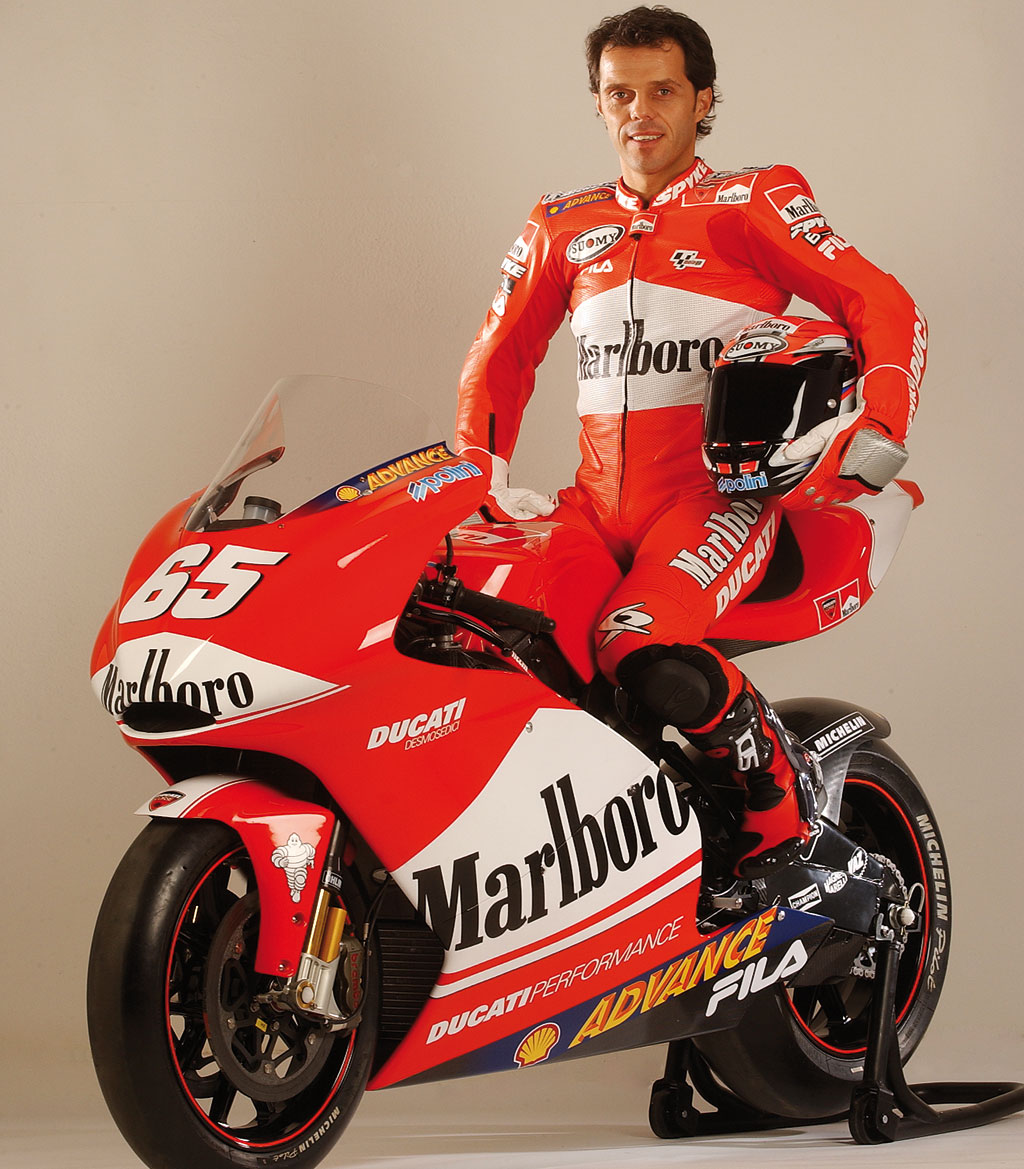
For Ducati and Loris, in
Rossi wins, followed by Biaggi, but immediately behind it is Capirex! The rider of Borgo Rivola has matured, capable of fantastic laps in practice and winning after six races: at the end of the season he will be fourth and Ducati will be second only to Honda in the constructors’ standings.
In 2004 it seems to arrive, with retroactive effect, the bill to be paid for the novitiate of the House of Borgo Panigale: the bike has been turned upside down, the difficulties immediately become clear; however, Loris Capirossi and the team roll up their sleeves: the lost competitiveness is recovered at the end of the season.
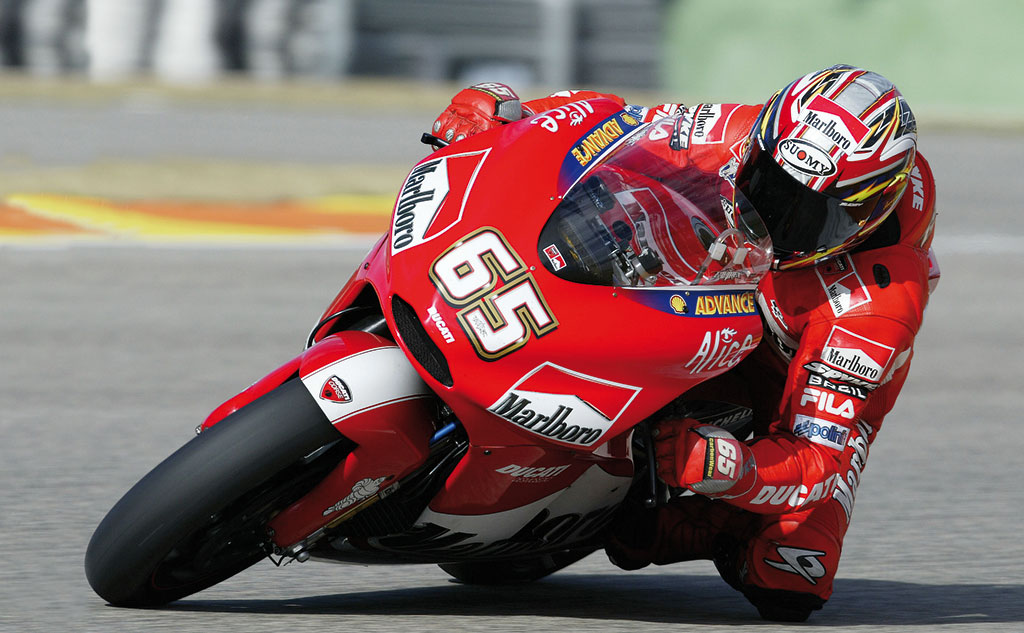
In 2005, Loris had Carlos Checa as his teammate,in place of Bayliss. In the first part of the season he took a third place at Mugello, until, again in Japan, in Motegi, he confirmed with the victory his and his bike’s competitiveness. It will be repeated in the next race, in Malaysia.
The basics of the 2006 season are solid, the team-mate still changes (now there is Sete Gibernau), but Loris is the prophet of ducatist fans: pole, victory and fast lap in the debut race in Spain. For the first time, thanks also to flattering and consistent placings, he firmly reaches the top of the rankings: now he is fighting for the world title.
The dream of Loris and the men of Ducati Corse breaks immediately after the start of the seventh race, in Barcelona; from the tangle of bodies and motion triggered by Gibernau himself, Loris comes out battered: still an injury, serious, to mark a setback in his career. Ducati is competitive, but it had bad luck. The bitter-sweet try is Bayliss’ one-off win to replace Gibernau at the Valencia Grand Prix.
Loris is the one who believed first in the Desmosedici project, the one that won ducati’s first pole and first MotoGP victory.
It still seems like a solid basis for the following season and in fact it is for Ducati, but not for Loris.
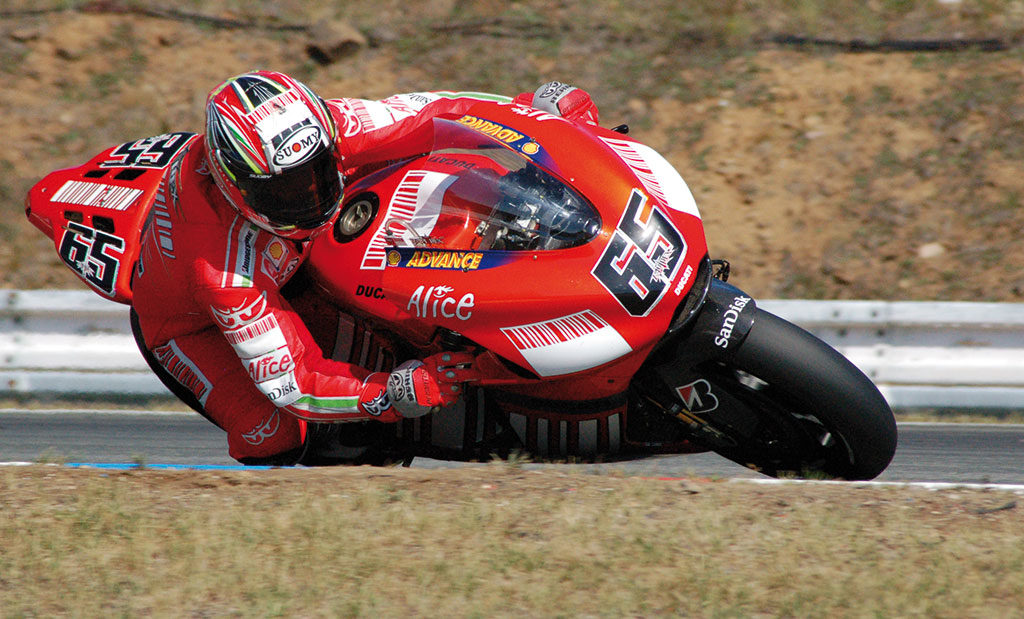
In Borgo Panigale comes Casey Stoner, among a thousand doubts (given his reputation as a waterfall): it seems that, once again, Loris can represent the spearhead of the team, even now that the displacement has been reduced to 800 cc. Right from the start, however, it is clear that this time it will not be so: Capirossi struggles to recognize the bike, finding it difficult, while the young Australian immediately makes it his winning weapon.
The situation is heavy: on the one hand Stoner, with his victories, on the other Loris, who drowns! Curiously, they are the basis of Desmosedici’s departure from any rider who is not called Stoner, a situation that Ducati also pays in the Rossi era.
At the end of the season Stoner will be worldchampion, with Ducati excelling as a constructor: for Loris the comparison is tough, even if he wins in Japan; at the end of the season, Capirossi’s move to Suzuki was greeted with disappointment by the ducatisti.
Ducati chose Melandri and for him exclusion is a bitter bite to send down. In the move to Suzuki, Loris seeks redemption, but his will be three years to go.
In the
However, the season on the horizon, after 22 years spent on circuits all over the world, will not see him at the start. The injuries, the difficulties encountered, have handed Loris and his numbers to the legend, to the history of sports motorcycling. The farewell, announced in the press conference before the Misano race, was moved, but serene: tears in the eyes and a smile on the lips.
Photo Micro and Mega, Marco Rimondi and Ducati World Archive
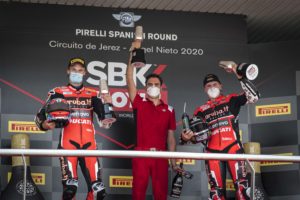
SBK a Jerez: avanti tutta!
A Jerez de la Frontera, seconda tappa del campionato SBK, si ri-accende lo spettacolo con Ducati protagonista. Doppietta di Redding e secondo posto in gara 2 per Davies.
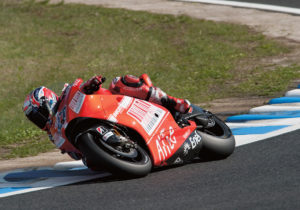
Desmosedici da MotoGP: su misura per Stoner
Cosa sta succedendo alla Desmosedici in MotoGP? A parte l’australiano Casey Stoner, infatti, gli altri sono in crisi nera.

